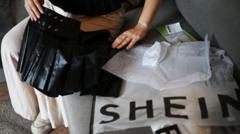Forever 21, once a beloved brand among the youth, is facing bankruptcy while continuing operations. Smarting from economic pressures and fierce competition, the fast-fashion retailer is set to conduct liquidation sales and may consider selling its assets.
Forever 21 Steps Towards Bankruptcy: A Decline of Fast-Fashion Icon

Forever 21 Steps Towards Bankruptcy: A Decline of Fast-Fashion Icon
Forever 21 has filed for bankruptcy protection in the US while keeping its stores and website operational.
Forever 21 could be on the brink of a significant operational shift as it filed for bankruptcy protection, signaling challenges that stem from rising prices and the rapid growth of online shopping. The brand, known for its trendy and budget-friendly attire, has struggled to maintain its customer base in the face of intensifying competition from both domestic and foreign fast-fashion companies.
While the retailer aims to keep its US stores and website running during this tumultuous time, the company informed stakeholders that it would begin the process of winding down its operations. Brad Sell, Forever 21’s chief financial officer, cited the difficulties of carving out a sustainable future due to escalating operational costs and the economic strain felt by its core customers.
This is not the first time Forever 21 has sought refuge in bankruptcy; the firm previously filed for bankruptcy in 2019 but was saved by a group of investors who subsequently acquired the brand through a joint venture. The current situation, however, emphasizes an ongoing struggle for the company, as its brand equity faces erosion from both foreign fast-fashion rivals and changing consumer preferences.
In the announcement, Forever 21 disclosed that the latest filing under Chapter 11 protection would allow them to delay their obligations to creditors while exploring avenues for debt restructuring or potential asset sales through a court-supervised process. The firm indicated that the potential successful sale of its assets could pave the way for a strategic pivot away from a comprehensive shutdown of operations.
It is worth noting that Forever 21’s international stores and e-commerce operations remain unaffected by this bankruptcy, as they are managed by separate license-holders. The brand, established in Los Angeles in 1984 by South Korean immigrants, gained immense popularity over the decades, expanding to 800 locations at its apex in 2016, with 500 stores in the US alone.
The future of Forever 21 hinges on its ability to navigate these adverse conditions while competing in a radically transformed retail landscape dominated by online sales and evolving consumer priorities. As it enters this new chapter, stakeholders and fans of the brand will be watching closely to see how it responds to these substantial challenges.
While the retailer aims to keep its US stores and website running during this tumultuous time, the company informed stakeholders that it would begin the process of winding down its operations. Brad Sell, Forever 21’s chief financial officer, cited the difficulties of carving out a sustainable future due to escalating operational costs and the economic strain felt by its core customers.
This is not the first time Forever 21 has sought refuge in bankruptcy; the firm previously filed for bankruptcy in 2019 but was saved by a group of investors who subsequently acquired the brand through a joint venture. The current situation, however, emphasizes an ongoing struggle for the company, as its brand equity faces erosion from both foreign fast-fashion rivals and changing consumer preferences.
In the announcement, Forever 21 disclosed that the latest filing under Chapter 11 protection would allow them to delay their obligations to creditors while exploring avenues for debt restructuring or potential asset sales through a court-supervised process. The firm indicated that the potential successful sale of its assets could pave the way for a strategic pivot away from a comprehensive shutdown of operations.
It is worth noting that Forever 21’s international stores and e-commerce operations remain unaffected by this bankruptcy, as they are managed by separate license-holders. The brand, established in Los Angeles in 1984 by South Korean immigrants, gained immense popularity over the decades, expanding to 800 locations at its apex in 2016, with 500 stores in the US alone.
The future of Forever 21 hinges on its ability to navigate these adverse conditions while competing in a radically transformed retail landscape dominated by online sales and evolving consumer priorities. As it enters this new chapter, stakeholders and fans of the brand will be watching closely to see how it responds to these substantial challenges.





















